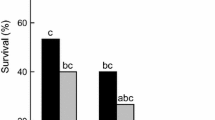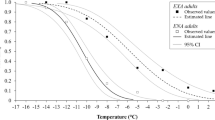Summary
The Antarctic oribatid mite Alaskozetes antarcticus was collected from several field habitats near Great Wall Station (62°13′S, 58°58′W) on King George Island during January and February 1990. The tritonymphs and adults were examined for their supercooling ability and survival at subzero temperatures in relation to inoculative freezing. The active tritonymphs and adults showed a wide range of supercooling points probably due to their polyphagous feeding activity and humid habitat conditions, with means ranging from -3.8° to -22.4°C. Detrivores were inferior to algivores in their supercooling ability. The former seemed to be transiently exposed to the hazard of freezing during the cool Antarctic summer. The resting (premoulting) tritonymphs exhibited the lowest mean supercooling point of -28.3°C. Inoculative freezing reduced the survival of A. antarcticus. Its effect became conspicuous at temperatures below -20°C and was serious in the deeply supercooled individuals, such as resting tritonymphs and algivorous adults. During the active season, spontaneous freezing probably started from the gut contents seemed to be more fatal than inoculative freezing for this freeze intolerant species.
Similar content being viewed by others
References
Block W (1984) Terrestrial microbiology, invertebrates and ecosystems. In: Laws RM (ed) Antarctic ecology, vol 1. Academic Press, London New York, pp 163–236
Block W, Duman JG(1989) Presence of thermal hysteresis producing antifreeze proteins in the Antarctic mite, Alaskozetes antarcticus. J Exp Zool 250:229–233
Block W, Sømme L (1982) Cold hardiness of terrestrial mites at Signy Island, maritime Antarctic. Oikos 38:157–167
Block W, Young SR, Conradi-Larsen EM, Sømme L (1978) Cold tolerance of two Antarctic terrestrial arthropods. Experientia 34:1166–1167
Cannon RJC (1986a) Effects of contrasting relative humidities on the cold tolerance of an Antarctic mite. J Insect Physiol 32:523–534
Cannon RJC (1986b) Effects of ingestion of liquids on the cold tolerance of an Antarctic mite. J Insect Physiol 32:955–961
Cannon RJC (1987) Effects of low temperature acclimation on the survival and cold tolerance of an Antarctic mite. J Insect Physiol 33:509–521.
Cannon RJC, Block W, Collett GD (1985) Loss of supercooling ability in Cryptopygus antarcticus (Collembola: Isotomidae) associated with water uptake. Cryo-Lett 6:73–80
Lee RE Jr, Baust JG (1981) Seasonal patterns of cold-hardiness in Antarctic terrestrial arthropods. Comp Biochem Physiol [A] 70:579–582
Salt RW (1966) Factors influencing nucleation in supercooled insects. Can J Zool 44:117–133
Wallwork JA (1967) Cryptostigmata (Oribatid mites). In: Gressitt JL (ed) Entomology of Antarctica (Antarct Res Ser 10). Am Geophys Union, Washington DC, pp 105–122
Wynn-Williams DD (1985) Photofading retardant for epifluorescence microscopy in soil micro-ecological studies. Soil Biol Biochem 17:739–746
Young SR, Block W (1980) Experimental studies on the cold tolerance of Alaskozetes antarcticus. J Insect Physiol 26:189–200
Author information
Authors and Affiliations
Rights and permissions
About this article
Cite this article
Shimada, K., Pan, C. & Ohyama, Y. Variation in summer cold-hardiness of the Antarctic oribatid mite Alaskozetes antarcticus from contrasting habitats on King George Island. Polar Biol 12, 701–706 (1992). https://doi.org/10.1007/BF00238870
Received:
Accepted:
Issue Date:
DOI: https://doi.org/10.1007/BF00238870




